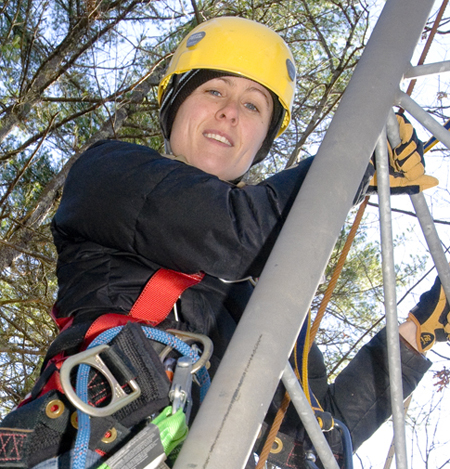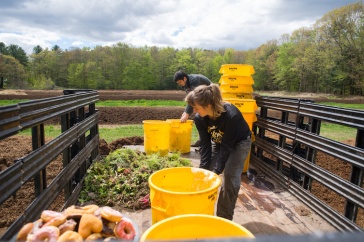|
|

Graduate student Elizabeth Burakowski prepares to climb a tower and set up an albedometer to measure how much radiation reflects off the forest canopy.
The air at ground level was still last December when Elizabeth Burakowski and Bob Evans, a U.S. Forest Service tower-climbing trainer, prepared to ascend a tower in Durham. But, up 100 feet the wind was blowing. Their task was to place an albedometer—an instrument that measures “albedo” or how much radiation reflects off of a surface—on a boom to extend out over the forest canopy.
For Burakowski climbing is all in day’s work as she earns her doctorate in Earth and environmental science in the interdisciplinary Natural Resources and Earth System Science (NRESS) Ph.D. program at UNH.
“We understand that recent winter warming trends are linked to greenhouse gases, but over the long term we still don’t know yet what impact the change in surface albedo has had on winter temperature,” Burakowski says. “I aim to answer this question in my dissertation.”
In 2008, Burakowski, working with her adviser Cameron Wake of the Institute for the Study of Earth, Oceans, and Space, conducted the most rigorous analysis to date of wintertime climate data in the northeastern U.S. from 1965 to 2005. Their findings, which were published in the peer-reviewed Journal of Geophysical Research-Atmosphere, showed that the region’s signature wintertime conditions are disappearing at an ever-increasing rate.
The warming trend of the past 40 years in the northeast coincides with a period during which global and northern hemisphere surface air temperature increases are driven primarily by enhanced levels of manmade greenhouse gases in the atmosphere. The period also has seen a significant decline in the extent of Arctic sea ice. The 11 warmest years in the global instrumental temperature record (since 1850) have occurred since 1995.
|
|
Surface albedo — an absorbing topic
Burakowski’s doctoral study will be the first to measure the albedo of the New Hampshire landscape in winter and is part of the NH EPSCoR “Ecosystems and Society” research project.

Elizabeth Burakowski
Why is it important in New Hampshire and the region to understand surface albedo in winter?
“In New Hampshire the decrease in surface albedo can amplify a small amount of global warming. This results in even greater regional warming,” says Research Associate Professor Cameron Wake. When a little warming removes snow cover, the sun shines on the darker surface, which absorbs more energy, warms up faster, enhances warming, and melts more snow. “It sets up a vicious cycle for much warmer winters,” Wake explains.
To understand climate change in our region and elsewhere, scientists need to tease out the role of surface albedo. Burakowski’s research is an important beginning.
“Today, New Hampshire is the second most forested state in the U.S. with nearly 80 percent forest cover, which is typical for New England,” Burakowski says. “Now imagine the New England landscape over 100 years ago, deforested to make way for sheep pasture, fuel homes, and support a booming lumber and paper mill industry. In 1870, as a result of land clearing, New Hampshire’s forest cover dropped to below 50 percent.”
A snow-covered field has a very high albedo, reflecting most of the sun’s energy back out to space, leaving very little energy to be re-emitted as heat. The dark forest canopies that have regrown since 1870 now absorb much of the sun’s energy and help to warm the landscape.
“It’s not unlike choosing to wear a white t-shirt on a sunny day,” Burakowski says. “A white t-shirt, like a snow-covered field, reflects solar energy to keep you cool. While a dark t-shirt, like a forest canopy, absorbs solar energy and increases surface temperature. Deforestation is like putting a white t-shirt over the landscape, and reforestation is like putting a black t-shirt over it.”
Globally averaged, notes Burakowski, changes in land use have resulted in cooling over the period 1850 to present due to sustained deforestation over much of the Northern Hemisphere. But this is not the case in the northeastern U.S. where forests have been regrowing since the late 1800s. This region has likely experienced warming due to changes in land use.
Building a baseline measure
Burakowski plans to build a baseline measure to understand the effect of land use on albedo in New England. She’ll do this using many tools including satellite imagery, tower and field placement of albedometers, and snow data gathered by a group of 18 “citizen scientists.” It’s a long-term project, and eventually, she even hopes to equip her volunteers with infrared temperature guns to evaluate how changes in albedo affect temperature. Finally, using computer models, she’ll recreate historical levels and project future ones.

Elizabeth Burakowski (right) and Bob Evans (left), a U.S. Forest Service tower-climbing trainer, team up along with David Hollinger of the USDA Forest Service on the ground (not in view) to place an albedometer on a tower in Durham, N.H.
Burakowski’s volunteers are all self-proclaimed weather nuts and members of the Community Collaborative Rain Hail and Snow Network (CoCoRAHs). They tend to be pretty plain spoken.
As for the snow this past winter, citizen-scientist Midge Eliassen says simply, “It was rotten.”
Nonetheless, everyday this winter at solar noon, Eliassen trudged outdoors to measure the snow or lack thereof. Then using a metal tube, she’d take a snow core, cap the tube and weigh it on a scale.
“They’ve got a calculation to figure out how dense the snow is. It makes a difference in the albedo readings,” says Eliassen, who is also a longtime water monitor for the Lake Sunapee Protective Association. “For example, now I understand the difference in the reflectivity of a conifer versus a deciduous tree canopy. I never knew about albedo until this study.”
Elizabeth Burakowski’s research is funded by NH EPSCoR’s “Ecosystems and Society” project, an award from the National Science Foundation’s Experimental Program to Stimulate Competitive Research (NSF# EPS-1101245). Find more information about NH EPSCoR.
Written by Carrie Sherman

















































